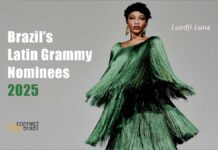Tropicália remains Brazil’s most misunderstood musical movement, a reality check decades in the making.
Tropicália’s unvarnished truth? Fighting for cultural identity and freedom of speech in the face of government oppression. Sound familiar?
Today – five decades after its turbulent beginning – Brazil’s Tropicália remains a musical enigma. Ignited by Gilberto Gil’s exuberance and strengthened by Caetano Veloso’s determination, the music of Tropicália took on the movement’s most public and controversial face.
Tropicália was just one of many stories from 1967, the most dynamic year for Brazilian music in the country’s history. Many view Tropicália as a defining moment in Brazilian culture, while others wonder if the results matched the vision.
Much of the confusion comes from the seeds of Tropicália’s birth and from the social needs of Brazil’s youth generation of the late 60s. Like most of the Western World, they were ready to make an indelible cultural statement of their own.
Tropicália’s musical movement lasted less than two years, from early 1967 to the Brazilian spring of 1968. Only a handful of true Tropicalia albums were ever recorded but its legacy is a lasting one.
Tropicália gave birth to a peculiar form of Brazilian Rock. It challenged the future of MPB (‘Música Popular Brasileira’ or Brazilian popular music). Tropicália skyrocketed the careers of several Brazilian musicians, including Gal Costa, Caetano Veloso, Gilberto Gil, Rita Lee, and Tom Zé.
Tropicália’s tragic end led to the Brazilian protest song, somewhat mirroring the social upheaval found in many other parts of the world during this time.
But was Tropicália more than a short-lived musical trend? It’s debatable, as you will soon learn.
The movement’s beginnings can be traced to a single event. Hélio Oiticica’s art exhibition, ‘Tropicália’ which debuted at the Museum of Modern Art in Rio in April of 1967.
The story of Tropicália’s Unvarnished Truth begins here.
Tropicália’s Frustrated Foundation
Tropicália was rebellion. Its theme of cultural nonconformity was strengthened by the notion that Brazil had lost its way. Tropicália quickly spread throughout the art world to include poetry, painting and sculpture, and the theater. Its generational appeal soon led to media, marketing, and advertising usage.
Today, the term Tropicália has been distilled to a catchy phrase for businesses wanting to trade on the emotional appeal of the word. You can buy Tropicália t-shirts, or coffee or eat at a Tropicália restaurant.
There’s a general lack of understanding about this period of Brazilian music and art. It’s been further compounded by the media’s social agenda, or from a desire to recategorize or misinterpret Tropicália’s story.
Maybe that’s part of Tropicália’s legacy, too. And Caetano Veloso would agree. When asked during an interview to promote a concert in Chicago, he was asked: “Was Tropicália a fad or a trend?” Veloso replied, “Yes, a fad. No, a trend. It was both actually.”
It was Rio de Janeiro’s art world that first advanced Tropicália’s concept of counter-culturalism. The movement took a stand against the closely-held traditions of Brazilian society.
Just like Hélio Oiticica’s artwork, Tropicália’s musical side willfully created tension with Brazil’s musical establishment. It infused traditional musical styles with outside, international influences including the Beatles and Iê, Iê, Iê, and the Bolero. Even American Top 40 was used to confront the status quo.
The problem was that most of the Brazilian people weren’t ready to join this brash and unstructured revolution.
Families and businesses were still dealing with the real revolution, the one that had plunged their nation into Military dictatorship less than three years earlier.
Setting the Stage for Tropicália’s Unvarnished Truth
Understanding Tropicália and its place in history requires some cultural and political background. Many reports on the Tropicália ‘movement’ overlook this step, leading to only a partial understanding.
We’ll be brief.
Brazil’s Political Climate
Tropicália began its life in the 3rd year of a 21-year military dictatorship. This action overthrew the democratically elected government of Brazil’s leftist President, João Belchior Marques Goulart in March 1964.
Even supporters viewed the leftist Goulart as a weak, ineffective, and sometimes bumbling leader. He struggled to reform Brazil’s cascading economic woes caused by massive spending by Brazil’s previous president, Juscelino Kubitschek. True to his politics, Goulart tried to apply the communist tactic of wealth redistribution and stronger control over citizens by government edict.
The Cuban missile crisis and Communism’s rise in Latin America were major concerns for the Kennedy and Johnson administrations in America. The CIA was directed by US Attorney General Bobby Kennedy to observe Goulart’s ties to Communist organizations.
Ultimately, the USA offered to assist Brazil’s military leaders, who considered a coup as a final option to preserve Brazil’s democracy.
This coup was defined as a ‘democratic rebellion’ by the U.S. ambassador to Brazil. There were fears that Goulart would install a Communist government in the most populous country of Latin America.
Regardless, Brazil – which has never known civil war, and gained its mostly-amicable independence from Portugal – was instantly transformed.
Brazil’s democracy was cast away by a determined faction of its own government.
But it wasn’t the first time.
Getulio Vargas in the 30s
Brazil’s history from the 30s reminds us that the difference between Socialism and Fascism is a distinction without a difference.
Any form of government or society which willfully restricts and outlaws personal freedom and free speech for “the greater good” is equally destructive to the cornerstones of Democracy.
Brazilian President Getúlio Vargas provides a nessessary example for Tropicália’s unvarnished truth.
In 1930, Vargas overthrew the newly-inaugurated President of Brazil after a messy, contested election, and he proclaimed himself Dictator.
Within 100 days Brazil was transformed from a democratic Republic into a Fascist state, the Estado Novo. Vargas’s control lasted until 1945 when he was forced out by the Brazilian military. Vargus ran and was legitimately elected as President of Brazil in 1951.
Consequently, many Brazilian adults in 1964 accepted the military’s role as a legitimate step in protecting their Democracy. However, this view was not universally shared, especially by members of the creative community, Universities, and Brazil’s so-called Intellectual class.
Tropicália’s Cultural Climate
1922’s ‘Week Of Modern Art’ focused Brazil’s attention on the art world and accelerated its role in creating a contemporary cultural identity. But its push against the status quo resulted in a different sense of Brazilian nationalism.
The ‘Week Of Modern Art’ promoted the writings of Brazilian philosopher Oswaldo de Andrade. His idea of cultural cannibalism (adding foreign influence to create a uniquely ‘Brazilian’ culture) quickly fueled the imagination of the country.
It became a unknowing blueprint for Tropicália and its role in the country’s cultural rebellion in the late 60s. But it wasn’t the only factor.
South American Ways
October 12th, 1930. Guglielmo Marconi was set to illuminate the statue of Christ atop the Corcovado mountain in Rio de Janeiro for the very first time.
Marconi was nowhere near Brazil for this historic moment and in fact, this history-making moment never occurred.
Marconi flipped a switch and a radio signal transmitted halfway around the world from his yacht in Rome, Italy, But it failed to connect, so the famous statue was lit by local workers in Rio instead.
Three years later, the Pan-Am clipper began its regular service to Rio de Janeiro from Miami.
Brazil was changing. In 1942, Walt Disney’s Donald Duck and Mickey Mouse introduced us to a cartoon Brazilian parrot, José Carioca on movie screens worldwide. It was part of Franklin Delano Roosevelt’s ‘Good Neighbor’ wartime policy.
During this time the United States partnered with Brazil to help grow its infrastructure. This improved roads and highways and the cars that used them, electrical power plants, and telephone networks. US retailers soon followed.
And when Brazil decided to relocate its nation’s capital from Rio de Janeiro to the newly constructed city of Brasilia in the late 50s, it turned to a New York-based engineering firm to assist with the final location. US bulldozers were airdropped into the isolated area to create roadways and housing sites.
Over the years, Brazil’s connections to the US began to influence its culture, and many Brazilians objected. They decried the strong presence of American culture mingling with their own.
It was far cry from Brazil’s early cultural connectedness to France in the 1800s when fashionable Cariocas and Paulistas would sport the latest full-length Paris fashions in the heat and humidity of the tropical night.
- Understanding Brazil’s cultural and political past is essential to appreciating Tropicália’s unvarnished truth.
Brazilian Music Follows Suit
Brazilian music was not spared from this growing sense of nationalism.
Today, you can still find critics who believe that Bossa Nova was nothing more than a bastardized version of American jazz. For Brazilian parents of teenage children, it was even worse. Cauby Peixoto recorded the first original Brazilian Rock single, ‘Rock n’ Roll em Copacabana’ in 1957. Soon Portuguese language versions of American and European rock tunes were popping up everywhere.
The Roots of Tropicália
Bossa Nova’s innocent views of the world quickly faded in the face of the military coup in 1964. At the same time, the Beatles landed in Brazilian record stores and radio stations. Fascination with Iê, Iê, Iê (Yeah, Yeah, Yeah) gave way to the creation of the Jovem Guarda (Young Guard), a pop music style similar to American Top 40.
The lyrics of these songs didn’t focus on the reality of Brazilian life or social issues. Instead, the songs promised a better one. Fancy cars, school days, romance, and the latest clothing fads. Just like the USA.
The popularity of the Jovem Guarda grew quickly with Brazilian teens, who idealized a younger singer named Roberto Carlos.
One song, ‘Quiera Que Tudo Mais Vá Pára O Inferno’ became their rallying cry against the conventional thinking of Brazilians and the cultural status quo. Translated, the song’s title means ‘I Want All The Rest To Go To Hell’.
Filling A Musical Void
Brazil’s love affair with Bossa Nova ended with 1964’s Dictatorship and many of its star performers came to America’s greener pastures. This created a void in Brazilian songwriting and the ‘old guard’ of long-established songwriters returned to fill it.
Top performers like Elis Regina and Nara Leão and established songwriters (including Chico Buarque and Dorival Caymmi) saw an opportunity to reassert their influence.
But a group of young musicians from Bahia argued for a ‘musical expansion’. Leading the way were a pair of rising stars from Bahia. Caetano Veloso and Gilberto Gil.
Bahia had become the hotbed of new music for Brazil, and these two mapped out a plan to advance their ideas.
Veloso and Gil combined the traditions of Brazilian music with a distilled blend of the Beatles and American Top 40, classical music, the psychedelia sunshine sound, and electronic rock.
The idea was to create a musical scene that became a two-sided carnival mirror. One side distorted the Brazilian establishment in comic relief while the other reflected an outward vision of worldly integration.
Veloso needed a name, and Hélio Oiticica’s Tropicália fit perfectly.
Other musicians united under Tropicália’s paisley umbrella, each with a distinctive sound. Gal Costa, Tom Zé, Rita Lee, and the group Os Mutantes led the way. Torquato Neto, and José Carlos Capinam joined, too. Rogério Duarte – who was a classical arranger and plastics artist – brought his production talents to the group.
Tropicália yielded few hit records, but if an anthem could be named, it might be Gilberto Gil’s ‘Geléia Geral’ or Caetano Veloso’s ‘Baby’ which launched Gal Costa’s reputation as Tropicália’s muse.
Gil’s ‘Domingo No Parque’ (Sunday in the Park) has become a classic, as have Veloso’s ‘Alegria Alegria’, (Joy, Joy), ‘Soy Loco Por Ti, America’, ‘Superbacana’ and ‘Tropicália’. But many of these songs came after Tropicália’s demise.
Kaleidoscope of Meaning
Most of Tropicália’s songs are a kaleidoscopic view of musical reality, drawing heavily on the Beatles’ early years (up to the Sgt. Pepper album). Pan-American styles and a healthy dose of Brazilian pop flavoring added to this musical feijoada.
But Tropicália’s music is always intrinsically Brazilian. You can hear capoeira rhythms in Gilberto Gil’s ‘Domingo No Parque’ layered into an arrangement inspired by the Beatles’ ‘A Day In The Life’.
There’s also a comic sense of cultural parody in Tropicália, too.
The lyrics, often witty and illogical, were meant to challenge conformity and Brazilian complacency. Covers of English lyric songs, like ‘Summer Rain’, are played ‘straight’, to illustrate Tropicália’s mission to author cultural differences by including the banality of cultural sameness found in other countries.
As free speech and human rights were eroded by governmental edict, Tropicália’s musicians ratcheted up their rhetoric. Lyrics were couched in fragmented imagery and double meaning.
Another part of Tropicália’s unvarnished truth? These musical creations went far beyond cultural mischief.
Many Brazilian songwriters (including Chico Buarque and his excellent use of cryptic analogies and wordplay in his protest songs, such as ‘Cálice’) fled the country in the face of censorship. Theere was also the very real threat of imprisonment by Big Government.
But the Tropicálistas remained in Brazil, awaiting their fate.
Tropicália’s Unvarnished Truth: Boiling Point
Sao Paulo, late 1968. Caetano Veloso takes to the stage with Rita Lee and Os Mutantes to sing his new song ‘É Proibido Proibir’ (It’s Forbidden to Forbid) at the Third MPB Music Festival competition.
Dressed only in plastic suits and backed by electric guitars, he challenges the audience to question the status quo of the ruling authority. He was met with catcalls and jeers. Caetano Veloso was booed off the stage.
Gilberto Gil’s song ‘Questão de Ordem’ (Question of Order) was disqualified from the competition due to its political content.
In December 1968, Brazil’s government enacted a series of laws that virtually eliminated free speech. There was little pushback from the media.
What happened next? The democratic constitution that the military had sworn to protect four years earlier was nullified.
A few short weeks later, both Caetano Veloso and Gilberto Gil were imprisoned and then exiled from their country for a time.
Rogério Duarte was detained and tortured by the regime, and it proved to be too much for the artist to cope with. He was committed to a hospital for the insane.
Torquato Neto eventually committed suicide as a result of his involvement and persecution. The rest went underground, or were jailed and later released.
Tropicália came to an abrupt end.
Tropicália’s Ironic Aftermath
What would Brazilian pop (MPB) sound like today without Tropicália’s role?
We can only imagine, but its legacy is a lasting one. Tropicália inspired the growing Brazilian protest movement of the ’70s and to the careers of Milton Nascimento, Ivan Lins, Joyce and others.
Tropicália aided the cultural shift that led to the Brazilian Military’s loosening of its dictatorial grip on the nation. Ultimately free elections were restored and a new, stronger democratic constitution was adopted in 1985.
Personal freedom and free speech were restored by the same Military that had removed them.
Brazilian music continues to invite and involve outside influences into its music by absorbing new ideas into the Brazilian sound, so perhaps a case could be made that, as Caetano Veloso has stated, “Tropicália was only a marketing exercise”.
Perhaps it’s fair to say that Tropicália exists with greater force in legend as opposed to the cold light of its brief reality.
Brazil in 1968 saw riots and military force in the streets of Rio, while America watched the riotous Democratic convention in Chicago. American protest songs made the Top 40 charts. Brazilian protest singers were arrested. This contrast in shared realities is telling.
In 1997, as part of Tropicália’s 30th Anniversary, Brazilian television aired a retrospective during which Gal Costa observed “Tropicálismo remains a reference for its generation. It’s important that these songs are remembered.”
We remember songs from the late ’60s which shaped young lives on this side of the equator. But now you know that Tropicália’s story isn’t really about music.
The price that Brazil’s Tropicálistas paid for standing up to an oppressive government in the name of personal freedom, cultural identity, and free speech was exile, torture, and death.
The best way to honor them is to learn from their human – not musical – experiences and to protect your own country’s promise of free speech and freedom for all.
Tropicália’s Unvarnished Truth
Stories like ‘Tropicália’s Unvarnished Truth’ are what we do. Why don’t you join us?
- Sign up for our emails on music, travel, friends and fun. Listen to our ‘always live’ streaming station and our 12 streaming music channels, always free. Browse our Lifestyle Directory. Click here to like our Facebook page and here for Brazilian events coast to coast.









